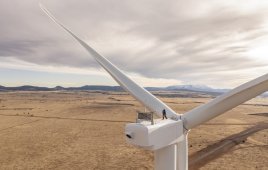A shortage of clean drinkable water spans the globe. A recent TV program highlighted the worldwide scarcity of potable water with one scene in particular from India showing men standing in a well handing buckets of slightly muddy water considered drinkable to those outside. A lawyer from Israel remarked to me that most patents issued in that country are for water use because it is so scarce. Even in the rural U.S. Southwest, running water is a not a standard home feature. The potable water shortage is visible most everywhere.
Now consider the Eole Water WMS1000 (www.eolewater.com) the Turbine of the Month from October 2012. For it, designers fashioned a condenser, part of an air conditioner, driven by a 30-kW, direct-drive turbine. Humidity that condenses on cooling coils drips into a holding tank and gets filtered into clean drinkable water. The unit can work in the dry air of the Middle East where it could produce 350 liters/day, but captures most, 50 to 60 liters/hour, says company spokesman Thibault Janin, near a coast. That would be about 1,200 liter/day. Water-borne diseases are a big problem in third-world countries and thinking of this sort seems one line of attack. A healthier population is a more productive one.

A closer look at the WMS1000 shows: 1 Rotor hub, 2 Blades, 3 Direct-drive generator, 4 Sandstorm shutters, 5 Cooling compressors, 6 Hydraulic unit, 7 Electrical box, 8 Water collector, 9 Humidity condenser, 10 Humidity condenser air blower, 11 Airflow regulator, 12 Heat exchanger, 13 Heat exchanger’s self-cleaning system, 14 Wind speed-and-direction sensors, 15 Heat exchanger’s air extractor
Now as they do in Texas, let’s think big. With limited funding, engineers at Eole Water sized a 30-kW turbine to drive its condenser. If the unit were to scale to, say, a 1.5 MW model, a size for which several production lines are already running, water production could top 60,000 liter/day. One hundred of these units could produce 6,000,000 liter/day, and 42,000,000 liters in a week. That could quench a lot of thirst.
Non-engineers have given the world a lot of bad ideas that don’t seem to go away, ideas such as communism, central planning, and the welfare state. Engineers solve real problems, create meaningful jobs, and push progress. In any case, if there were a Nobel Prize for Engineering, Eole Water should be the first candidate.
Filed Under: Turbines






What is estimated cost for one of these units, not including structural and civil components (understood that different locations would require different considerations, of course)? Definitively agree, it is quite a concept.
This is an amazing concept and design. I only hope this actually takes off and starts getting potable water to the people that need it.